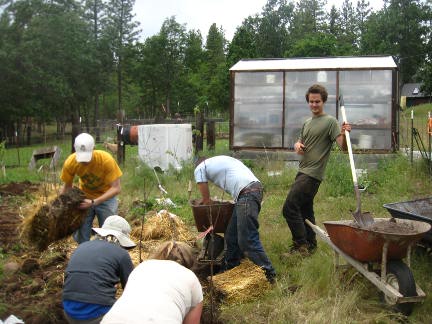Trees for the Forest
Lindsay:
Earlier this week, Mary Lou and I took a road trip up to Morton,
Washington where we joined other plant enthusiasts at Raintree
Nursery. I have long since admired Raintree's inventory of edible
perennials, as they always seem to have both heritage varieties from
all over the world and "new" discoveries from the centers of diversity
(e.g places of origin) for the various edible species they offer.
So,
I was very much delighted to learn that we would have the opportunity
to visit Raintree and bring home some of this year's remaining
bareroot trees. And while it was a full day of effort, with 8 hours in
the car, 3 hours standing in a cold storage facility and more time
loading the pick-up with the chestnuts and raspberries, asparagus and
grapes, apricots, apples and almonds, all the real work was yet to
come.
grapes for the garden
 |
| |
Ahead of me, and those who care to join me in the process, is the task
of transforming this piece of the plateau into a forest that is as
similarly well adapted and resilient to the summer droughts and clay
soils, burrowing ground squirrels and insatiable deer, as the native
pines and oaks but a forest that also produces food for our bodies,
forage for the working animals and the materials with which we will
build and fuel our lives here.
more baby nut trees (black walnuts)
 |
| |
What does this process look like? Well,
first it looks like many months of observation and research‒how are
the trees and the soil, grasses and pollinators, fungi, bacteria and
moisture all interacting to make this native forest function? What are
the sources of nitrogen, what are the patterns of growth‒both above
and below ground?
These questions are endless, and as I learn and
observe more, I simply am more curious and have more questions. But
this initial observation process is critical, for the vision is to
create an ecosystem that is similarly self managing and abundant. We
have both the burden and great fortune to be starting not with an open
field‒an empty canvas‒ as many other forest gardeners seem to start
with, but with a forest full of trees that started turning sunlight
into sugars well before the turn of the twentieth century.
Simultaneous to the observing is the necessary step of
propagation‒what trees and vines, bushes and shrubs do we want to
fill this forest?
grafted apples putting on leaves
 |
| |
A forest is by definition a long term
commitment‒trees invest great resources in building their below
ground biomass for the first several years so that that they will be
well prepared to grow for the next several decades.
Propagation is
similar. When time, not money, is my most abundant resource (even
though it too feels quite scarce), I am better enabled to propagate
the plants myself than buy them from someone else. And so inevitably
this means investing now in learning how to propagate apples and
grapes, walnuts and blueberries to be able to share in the future
abundance.
And so propagating a forest of food, forage and fiber looks
like time spent grafting, taking cuttings and starting from seed
(whatever method is best suited for the particular species you are
working with) species by species, variety by variety the plants that
will grow to create the forest. I am not able, nor would want, to do
all the varieties (or volume) at once, and so my hope is that every
year I can propagate a few more species and learn from mistakes made
in previous attempts.
the planting crew gets going |
| |
This year the focus has been apples, grapes,
locusts, walnuts and hazelnuts. When working with perennials such as
nut and fruit trees, I am constantly humbled by the time frame of my
efforts‒some trees such as chestnuts and walnuts can live for
hundreds of years, yet this means they can take many years before they
begin to flower and fruit. I am thankful that I have only seen two
decades of my life pass by so that there exists a very real likelihood
that I will be able to be part of the harvest, as seemingly so few
avid tree planters are.
Yet this trip to Raintree certainly jumpstarted these efforts as we
brought home several dozen trees plus 5 varieties of grapes, 4
varieties of raspberries and still even other perennial edibles. The
challenge with dealing with so many trees, is finding a place to put
them all in the ground where they will be safe from sheep and cattle
and can be easily watered through the dry summer months.
Sarah, Celeste and Andrew setting bare root trees in our nursery
 |
| |
Bareroot
trees are extremely vulnerable to drying out and have to be planted
immediately if they are to survive. So over the past few days, we have
been preparing ground to plant these several dozen fruit and nut
trees. We are digging a series of trenches and filling them with
compost and planting the trees at close intervals‒this way they will
be easy to tend to this summer and can be transplanted to more
permanent locations in the spring.
Sam adding lots of mulch to the new trees
 |
| |
Planting this many trees is no
trivial task, and the work goes fairly quickly when there are many
hands. As John so aptly noted‒this would be so much work for one
person to do! Indeed, it takes a small village to plant a forest, and
thanks to everyone's help over the past week, we are many trees closer
a diverse and productive canopy.
Notes From Windward - Index - Vol. 70
|
|





